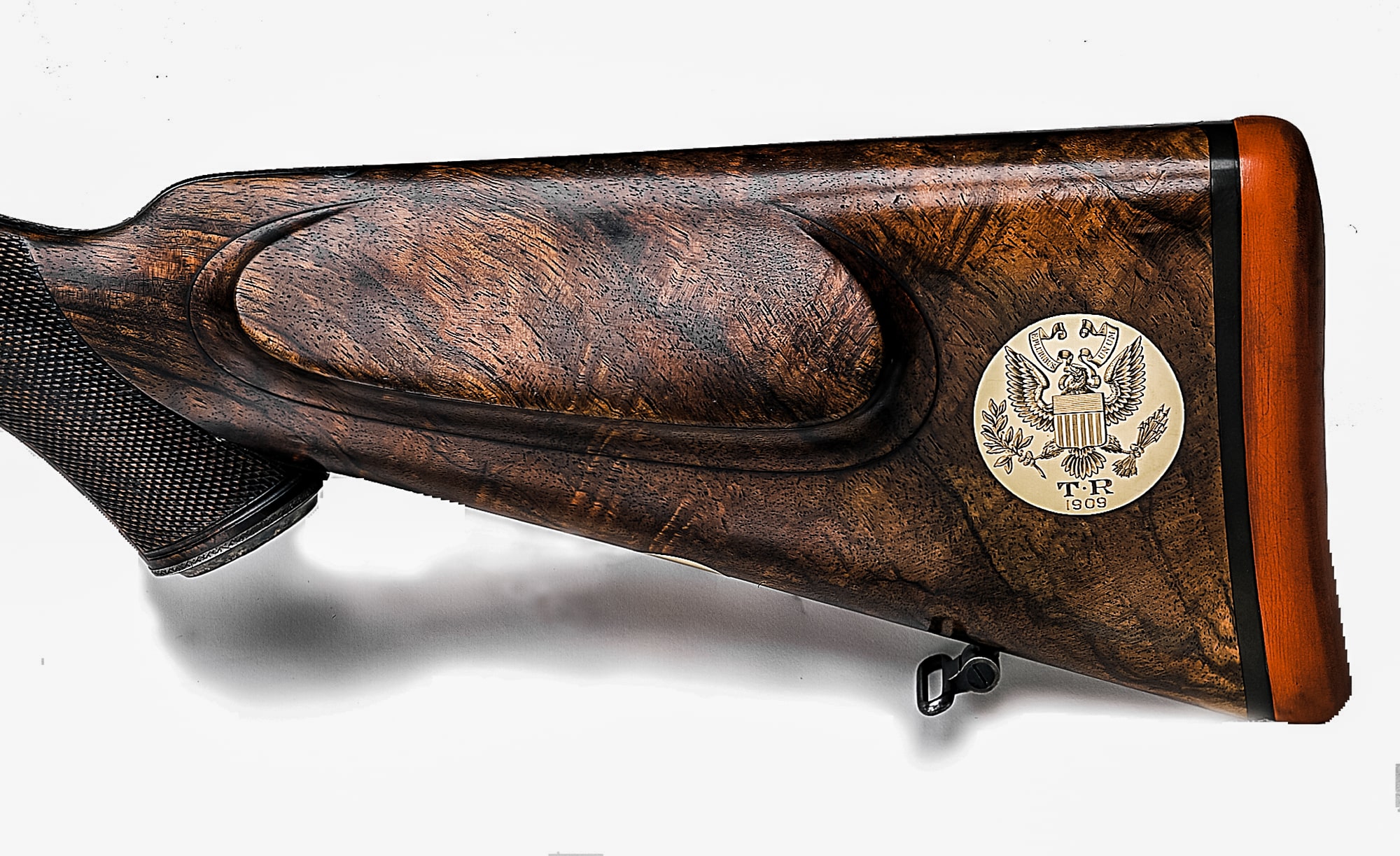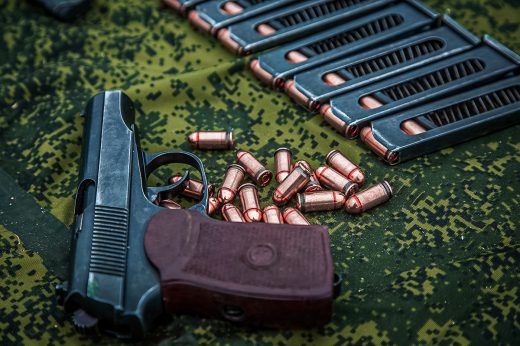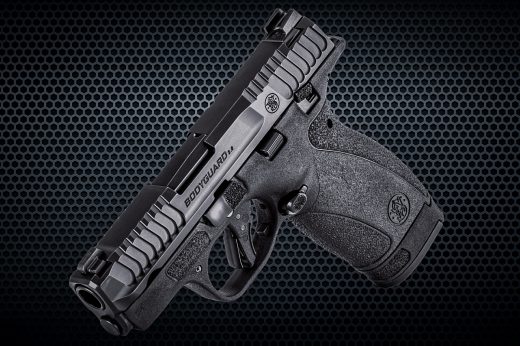Theodore Roosevelt, Holland & Holland, and Africa: a hunter, a gun, and a location that should send a little shiver of excitement and yearning up the back of every hunter. It’s a trifecta that speaks of a bygone era that many hunters aspire to meet in some way during their hunting careers. Roosevelt is a legend for an array of reasons, but for our purposes, we’ll put aside his presidency, wildlife and habitat conservation pioneering, and other accolades and just focus on TR, the hunter. Specifically, we’ll look at his trips to Africa and one of the many guns he took with him: the most famous double rifle ever made.
Roosevelt owned many guns in his lifetime, but the side-by-side Holland & Holland Royal Double Rifle bearing serial number: 19109 and chambered in .500/450 was far and away the finest and most famous firearm in his collection. It has become known as the “Big Stick” in reference to Teddy’s famous quote regarding his preferred “big stick diplomacy” tactic: “Speak softly and carry a big stick; you will go far.”

Roosevelt did indeed go far, both in his professional and personal life. His career took him to 1600 Pennsylvania Avenue and highest political office in the land, while his personal life and hunting career took him to the Dark Continent on more than one occasion.
Roosevelt did a remarkable amount of globetrotting — especially considering he did it in the age of the steamship and not the airplane — and so did his H&H double rifle; it accompanied him on hunts all over the world.
Today, the rifle no longer travels much; instead, it spends its time behind glass at the Frazier History Museum in Kentucky, carefully cared for by curators so that curious visitors can see, admire, and dream about the glory days of African hunting.
“We are in full agreement that this gun is a major mechanical, artistic, and romantic artefact [sic] of American, British, and African culture.”
— Holland & Holland, circa 1986
I made a personal pilgrimage to see this historic rifle that was more than a year in the making, but my visit was a bit more involved than that of most curious visitors.
When I arrived at the museum, the galleries were quiet; staff members were still making their way into work. In the dimly lit Founder’s Gallery, with the alarm off and the locked glass panels removed during a brief window of time before opening to the public, Roosevelt’s double rifle was removed from its exhibition mounts, and I was allowed to hold it with gloved hands.
I could instantly feel the weight of all 114 years of the masterful Holland & Holland’s history. In the early morning stillness of the museum, I swear I could almost hear the African plains come alive as I stood, reverent, gazing upon such a historic piece of firearms artistry and American history.
Making a Masterpiece

On Aug. 8, 1908, Roosevelt sent a letter to H&H — on White House stationery no less — describing the specifics he wanted for this recently commissioned double rifle. The length of pull was to be 14 3/8 inches to the front trigger, with a drop at the heel of 2 1/2 inches. The barrels were to be 26 inches long, and the overall length of the rifle should be 42 3/4 inches. Roosevelt set the trigger weight at 3 1/2 pounds.
Roosevelt made a drawing of his desired rear sight that was composed of two folding leaf sights and one fixed sight to be zeroed at 100 yards, paired with an elongated, gold front bead sight. H&H built it to spec.
The fixed 100-yard sight was zeroed and test-fired with a .500/450 load using 70 grains of cordite behind a 480-grain bullet in a 3 1/4-inch casing. The results were a group no larger than 2 1/8 by 1 1/2 inches. The load data is recorded on a label inside the rifle’s case, and it’s also engraved on the underside of the receiver.
A quick note on the ammo: “.500/450” means that a 3 1/4-inch .500 Nitro Express cartridge was necked down to hold a smaller .450-caliber bullet. In Roosevelt’s gun, the 480-grain bullet would be traveling about 2,000 fps with approximately 5,000 ft-lbs of muzzle energy. That’s a hearty, fast-moving projectile that could take anything on the continent, including dangerous game.

The gun also bears a top strap that extends halfway down the length of the stock, a way to strengthen the wrist against the very substantial recoil of the .500/450; this was a special request from Roosevelt.
No such double rifle of such design and execution could be complete without a case befitting the wooden and steel canvas. The gun was fitted with a case made of oak and leather, the exterior giving no indication of the luxury contained within.
Opening the case reveals a panel-wrapped, vibrant red fabric and an embossed leather label from Holland & Holland, hinting at the contents without completely giving away the functional piece of art contained within. Lifting the panel reveals more red fabric and the star of the show: the custom Royal Double Rifle.
The case was capped off with places for cleaning equipment, ammunition, sling, and bottles of rangoon oil. A special presentation label inside the lid listed each and every one of the 56 distinguished donors whose financial contributions made the gun a reality.

Upon completion, the gun came to the United States for delivery, went to Africa for plenty of hunting, remained in the former president’s family until the mid-20th century, was owned by multiple other semi-famous people, and went back to Africa for a safari with Roosevelt descendants. Finally, it settled into one last private collection before landing in the Frazier History Museum in Louisville, Kentucky.
Hands-On History — Hanging Out With T.R.’s Double Rifle
I’ve been fortunate enough in my professional life to handle firearms owned by multiple presidents of the United States, including George Washington, Andrew Jackson, Theodore Roosevelt, Dwight D. Eisenhower, Ronald Reagan, George H. W. Bush, and Donald Trump. With the exception of a pair of pistols owned by Washington, none of the others instilled awe and reverence in me like Roosevelt’s Holland & Holland Royal Double Rifle.
The Big Stick is in extraordinary condition, considering how much time it spent on safari and the fact that it’s more than 110 years old. The finish is surprisingly intact and in good shape. The engraving and checkering are still sharp. Furthermore, the original case and accessories are present.

In preparation for a 1986 safari with Theodore Roosevelt IV and Theodore Roosevelt V, the rifle was sent back to Holland & Holland to have some work done; it was about 80 years old at the time. The company remarked: “We are in full agreement that this gun is a major mechanical, artistic, and romantic artefact [sic] of American, British, and African culture.”
This is when the gun got a new forend from H&H. The original was lost by the family sometime in the 1940s and was replaced by the manufacturer in the same style as the original. It’s also likely that the orange butt pad and engraved stock medallion featuring the presidential eagle, TR initials, and 1909 date were added at this time, as those elements are not visible in any of the photos or footage of the gun in use by Teddy Roosevelt.
TR’s First Impressions of the H&H Double Rifle
In January 1909, Roosevelt had his first opportunity to test his new double rifle, and he recorded his thoughts.
“At last, I was able to get a day off and try the double-barreled 450. It is a perfect beauty,” he wrote. “The workmanship is like that of a watch. Of course, our [US-made] rifles look coarse and cheap and clumsy beside it. I can not say how delighted I am with it.”

Destination: Africa
Perhaps the most famous role the Big Stick played was on Roosevelt’s highly publicized African safari.
The safari began when Roosevelt’s party boarded a steamer loaded with all of their supplies on March 23, 1909, just 19 days after he left the presidency. Over the course of 10 months, Roosevelt’s party harvested 469 big-game animals, 262 of which were used to feed the hunting party and 150 others that were vital to the safari’s success.
Many of the others were brought back as museum specimens for the Smithsonian, which was underwriting much of the safari’s $75,000 cost. Adjusted for inflation, that’s about $2.4 million today.

The Holland & Holland double rifle was by no means the only weapon Roosevelt selected for the trip. In his arsenal were a Fox 12-gauge shotgun, two Winchester Model 1895 lever-action rifles in .405 Win., a Springfield in .30-06, as well as a Mannlicher rifle.
The double rifle was obviously of prime significance to Roosevelt and to the other safari participants, as reflected by the frequent references to it in his book, African Game Trails. The gun’s first true test was on a rhinoceros. Roosevelt would eventually kill 13 rhinos with the gun.
“I pushed forward the safety of the double-barrelled Holland rifle which I was now to use for the first time on big game…. The rhino saw me and […] as he rose, I put in the right barrel […] Before he could get quite all the way round in his headlong rush to reach us, I struck him with my left-hand barrel […] Ploughing [sic] up the ground with horn and feet, the great bull rhino, still [heading] toward us, dropped just thirteen paces from where we stood.”

He goes on to note, “For heavy game like rhinoceroses and buffaloes, I found that for me personally, the heavy Holland was unquestionably the proper weapon.”
The rifle was also well-suited for the elephant; Roosevelt used it to kill eight of them.
“As I aimed at his head, he started to move off; the first bullet from the heavy Holland brought him to his knees,” Roosevelt wrote of one elephant hunt. “And as he rose, I knocked him flat with the second.”

Apparently, the rifle had quite the felt recoil. Kermit Roosevelt noted that “the recoil of the big gun was so severe that it became a standing joke as to whether we did not fear it more than a charging elephant!”
Life of the H&H Double Rifle After Teddy
Roosevelt may have introduced the rifle to travel, but its subsequent owners have put plenty more miles on it.

Over the years, the gun has been owned by other famous people, though none quite as famous as TR. Richard P. Mellon, whose surname needs no introduction, and William E. Simon, former Treasury Secretary, were just two of the gun’s high-profile owners. In 1994, the gun was sold at auction for $500,000 before the buyer’s premium. It was eventually sold again and purchased by philanthropist Owsley Brown Frazier.
It has been on display at the Library of Congress, the Metropolitan Museum of Art, and the Smithsonian Institution and is now part of the permanent collection at the Frazier History Museum, which was founded by Frazier in 2004.
If you visit the museum when you’re in the area, you can see the Big Stick and other fine firearms in The Founder’s Gallery. The museum is also the starting point for the Kentucky Bourbon Trail, so that’s definitely a plus!
Few politicians’ personas are as intertwined with firearms as Theodore Roosevelt, and there’s no firearm more fitting for that connection than the Holland & Holland Royal Double Rifle known as the Big Stick.
READ NEXT – Teddy Roosevelt Ran a Suppressor on Three of His Hunting Rifles










Comments